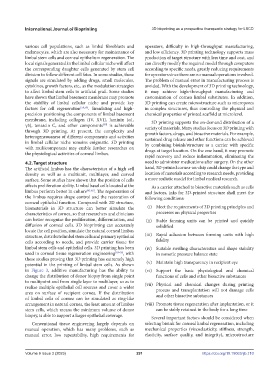Page 299 - IJB-9-3
P. 299
International Journal of Bioprinting 3D bioprinting as a prospective therapeutic strategy for LSCD
various cell populations, such as limbal fibroblasts and operators, difficulty in high-throughput manufacturing,
melanocytes, which are also necessary for maintenance of and low efficiency. 3D printing technology supports mass
limbal stem cells and corneal epithelium regeneration. The production of target structure with less time and cost, and
local signals generated in the limbal cellular niche will affect can directly modify the required model through computers
the corresponding daughter cells generated by stem cell according to specific needs, greatly reducing requirements
division to follow different cell fates. In some studies, these for operators since there are no manual operations involved.
signals are simulated by adding drugs, small molecules, The problem of manual error in manufacturing process is
cytokines, growth factors, etc., as the modulation strategies avoided. With the development of 3D printing technology,
to affect limbal stem cells in artificial graft. Some studies it may achieve high-throughput manufacturing and
have shown that limbal basement membrane may promote customization of cornea limbal substitutes. In addition,
the stability of limbal cellular niche and provide key 3D printing can create microstructure such as micropores
factors for cell regeneration [58,59] . Simulating and high- in complex structures, thus controlling the physical and
precision positioning the components of limbal basement chemical properties of printed scaffold at microlevel.
membrane, including collagen (IV, XVI), laminin (α1, 3D printing supports the on-demand distribution of a
γ3), tenascin C, and other components is achievable variety of materials. Many studies focus on 3D printing with
[60]
through 3D printing. At present, the complexity and growth factors, drugs, and bioactive materials. For example,
heterogeneousness of different components and activities sustained drug release and other functions can be achieved
in limbal cellular niche remains enigmatic. 3D printing by combining bioink/structure as a carrier with specific
with multicomponent may enable further researches on drugs at target location. On the one hand, it may promote
the physiological activities of corneal limbus. rapid recovery and reduce inflammation, eliminating the
4.2. Target structure need to administer medications after surgery. On the other
The artificial limbus has the characteristics of a high cell hand, 3D-printed cornea-on-chip could change the type and
density as well as a multiunit, multilayer, and curved location of materials according to research needs, providing
surface. Some studies have shown that the position of cells a more realistic model for limbal medical research.
affects proliferation ability. Limbal basal cells located at the As a carrier attached to bioactive materials such as cells
limbus perform better in culture [61,62] . The regeneration of and factors, inks for 3D-printed structure shall meet the
the limbus requires shape control and the restoration of following conditions:
corneal epithelial function. Compared with 2D structure,
biomaterials in 3D structure can better simulate the (i) Meet the requirements of 3D printing principles and
characteristics of cornea, so that researchers and clinicians processes on physical properties
can better recognize the proliferation, differentiation, and (ii) Stable forming units can be printed and quickly
diffusion of corneal cells. 3D bioprinting can accurately solidified
locate the cell position, simulate the natural corneal limbus
structure, distribute limbal stem cells and primary epithelial (iii) Rapid adhesion between forming units with high
cells according to needs, and provide carrier tissue for fidelity
limbal stem cells and epithelial cells. 3D printing has been (iv) Suitable swelling characteristics and shape stability
used in corneal tissue regeneration engineering [63-66] , with in osmotic pressure balance state
these studies proving that 3D printing has extremely high
potential in the printing of limbal stem cells. As shown (v) Maintain high transparency in recipient eye
in Figure 3, additive manufacturing has the ability to (vi) Support the basic physiological and chemical
change the distribution of donor biopsy from single point functions of cells and other bioactive substances
to multipoint and from single layer to multilayer, so as to (vii) Physical and chemical changes during printing
realize multiple epithelial cell sources and cover a wider process and transplantation will not damage cells
area on surface of recipient cornea. If the distribution and other bioactive substances
of limbal cells of cornea can be simulated as ring-like
arrangement in natural cornea, the least amount of limbus (viii) Promote tissue regeneration after implantation, or it
stem cells, which means the minimum volume of donor can be stably retained in the body for a long time
biopsy, is able to support a larger epithelial coverage. Several important factors should be considered when
Conventional tissue engineering largely depends on selecting bioink for corneal limbal regeneration, including
manual operation, which has many problems, such as mechanical properties (viscoelasticity, stiffness, strength,
manual error, low repeatability, high requirements for elasticity, surface quality, and integrity), microstructure
Volume 9 Issue 3 (2023) 291 https://doi.org/10.18063/ijb.710

